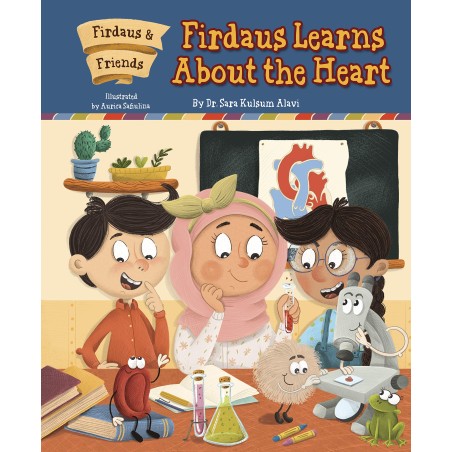



Firdaus & Friends is a brand new STEM series for children that features diverse characters and Islamic values. Firdaus goes to Medina Academy and she loves science class. Her teacher, Mrs. Ahmed, makes science exciting and easy to understand with diagrams, class experiments, activities, and fun facts. One night, Firdaus meets Rubbab and Wahhab, two blood cells, and joins them on a journey into the human body. During her many adventures, Firdaus meets new friends, explores the human body, and most importantly, learns what it means to have a good heart.
Firdaus & Friends is perfect for homeschoolers and Islamic Schools, and can supplement a Middle Grade Life Sciences curriculum. It features information about cells, organs, heart anatomy, and organ systems.
Linked Categories
Our Review
![]()
It’s a part fiction- part nonfiction book about the heart, where two stories are happening simultaneously. We follow Firdaus’s day at school with a focus on what she’s learning during science class (followed by one good deed of the day). However, at night she dreams of an adventure with Rubab the red blood cell and Wahab the white blood cell and their journey to the heart.
The story starts with Firdaus’s first day of school and an introduction to her classmates. The non-fiction science part introduces the reader to cells, tissues and organs and a basic overview of what the heart does with a focus on what blood cells are. This is followed by 4 short activities of matching, mazes, drawing, and solving a code. It ends with an experiment on heart rate. That night Firdaus dreams about meeting Rubab and Wahab reinforcing the concept of blood cells for the reader.
The next day the story continues at school, where one of the kids gets hurt and bleeds. Next they talk about blood and other constituents of blood like plasma, and platelets followed by a pretty great experiment that represents how platelets work to stop bleeding.
Then there’s a fact page about how cells need energy including oxygen and glucose followed by an experiment to show how cells use energy. The story continues with a good deed Firdaus does during the day with her grandmother. This is followed by part 2 of the Rubab and Wahab dream storyline where they get on a ship and enter the human body through the nose to the lungs. This is followed by another maze activity.
The next day at school, Firdaus learns about blood vessels and circulation. This is followed by a facts page on how the heart works. After that the author has included an experiment that helps kids understand how high cholesterol can block the heart. Firdaus’s story continues at home where she does a good deed at dinner time for her mom. That night we see part 3 of her dream and are introduced to a new character – Omer the oxygen. Firdaus, Rubab and Wahab help Omer navigate the heart chambers to his destination.
The next day Firdaus learns that she needs to prepare a presentation for the class which is followed by her helping her brother (good deed). A maze activity is next. The story ends with Firdaus’s presentation in which she summarizes all the important aspects of the heart and adds an important take away message.
It’s a part fiction- part nonfiction book about the heart, where two stories are happening simultaneously. We follow Firdous’s day at school with a focus on what she’s learning during science class (followed by one good deed of the day). However, at night she dreams of an adventure with Rubab the red blood cell and Wahab the white blood cell and their journey to the heart. The book also has pages with scientific facts and analogies, and related fun activities!
It’s a very unique book and an awesome supplement to your child’s Human Body Unit – whether your child goes to public school or you homeschool! It incorporates anatomical and physiological information of the heart as an organ, with an exciting story and Islamic values!
This is intended for kiddos in grade 4 to grade 6. However, if your younger child enjoys shows like “The Magic School Bus” and “Sid the Science Kid” they will enjoy this book as early as Preschool! Just remember to go slow so they can truly absorb the various aspects of the heart!
I truly look forward to the next book!